GIGABYTE Server GA-7PESH3 Motherboard Review
by Ian Cutress on September 4, 2014 2:00 PM EST- Posted in
- Motherboards
- Intel
- Gigabyte
- Xeon
- Workstation
- Enterprise
- C602
GIGABYTE GA-7PESH3 BIOS
An important point to realize with the major motherboard manufacturers is that the motherboard server team is a wholly different business unit to the end-user motherboard team. As a result, the only overlap between these two departments (apart from purchasing hardware) is at high level management. This usually means that the design teams do not talk to each other, the development teams do not talk to each other, and the BIOS/software teams are separate. This is a bit of a shame to be honest, because while the end-user side of the company is focused on delivering a good user experience, it does not translate over to the server side of the company which is more focused on robustness and support. This means that our BIOS interface, while technically an EFI/UEFI construct, is a simple text and select affair.
The front screen contains information on the BIOS version, the CPUs installed and the memory installed, but fails to mention which motherboard is in use. With standard graphical interfaces, even if they came to server implementations, would benefit from fan speeds and CPU temperatures on this screen as well.
The Advanced menu contains most of the motherboard options, especially the CPU configuration and the fan controls.
The fan controls are dire – for six fan headers, there is only one option and the rate of increase of fan speed is determined by a single value. For a workstation oriented motherboard, I would have assumed that an adaptive system would need to be in place.
The option for Above 4G Decoding, required for certain PCIe co-processors, is found in the PCI Subsystem menu and is disabled by default.
Users who are interested in every morsel of performance should head over to the CPU Power Management menu where the Energy Performance option should be changed to full performance. This makes the turbo modes more aggressive, maintaining a higher turbo on the CPUs for longer. We ran our system at the stock default option - balanced performance.
The GA-7PESH3 does support Hot Plug on the SATA ports, but this is disabled by default. This makes more sense if this motherboard is placed in a case with hot-plug bays rather than RAID applications.
Memory control is limited, with the Chipset -> North Bridge menu offering most of the options. The user can select the DDR3 Speed here, although sub-timing control is not offered. There is a DIMM information screen so diagnosis of an errant memory module can take place:
VT-d is also present, and in our configuration was enabled by default. There was no direction mention of VT-x in the BIOS.
The rest of the BIOS supports data logging for the management interface as well as boot order, fast boot options for Windows 8 and boot override functionality.
GIGABYTE GA-7PESH3 Software
For the reasons mentioned at the start of the BIOS analysis, the software system is similarly different to the channel motherboard market. There is no software directly usable or downloadable from the product page, and thus the management interface becomes the sole ‘software’ available for use.
The system uses a MergePoint EMS interface, similar what we saw on the GIGABYTE GA-7PESH1. After a login (default settings are admin/password) the above screen is shown, and if I were a server admin I would have like to see some indication of what hardware installed in the system on the front page, and if the machine is switched on and running, if one of a list of operating systems are detected.
As with these management systems, security is a major priority, and this system gives a level of IP blocking rather than an IP whitelist:
This is combined with a list of enabled users who have access:
The system can also adjust its web server management settings for the interface, giving timeouts and port selection.
The management system is based on a Linux kernel, as shown in the LDAP Configuration Page, which can also be updated akin to a firmware update:
One of the more important uses for the management software is remote control of the system. This comes in two parts – direct control over the state (on/off) of the system and the interface to the video output. The former is located in Power -> Control:
With the direct OS control provided by a virtual KVM over a Java based implementation:
Another aspect of the management center is keeping track of voltages, fan speeds and temperatures and indicating when they are out of the normal working window.
The GA-7PESH3 uses fourteen different temperature sensors for this, each of them with limits defined in firmware. I’m sure that a custom system would prefer these to be manually adjustable.
The management engine also keeps track of the system event log, for when the machine is booted or one of the aforementioned sensors goes out of optimal functioning parameters. When the temperature gets too high, or a fan fails, the system can react by forcing a reboot, power cycle or power the system down:


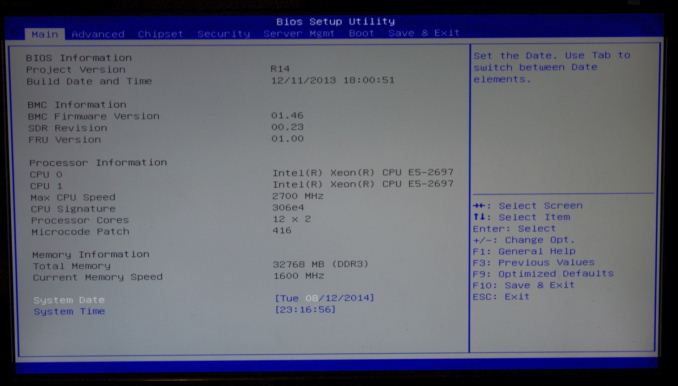
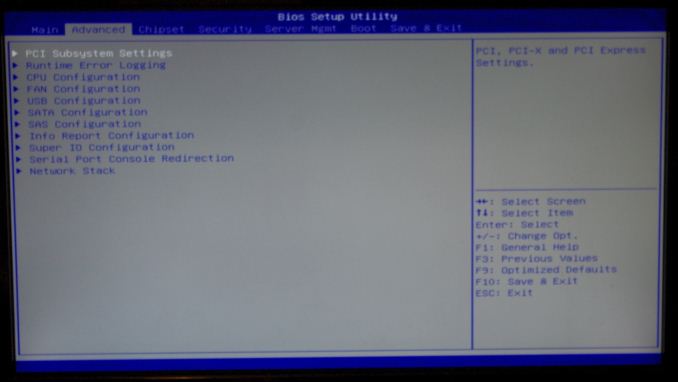
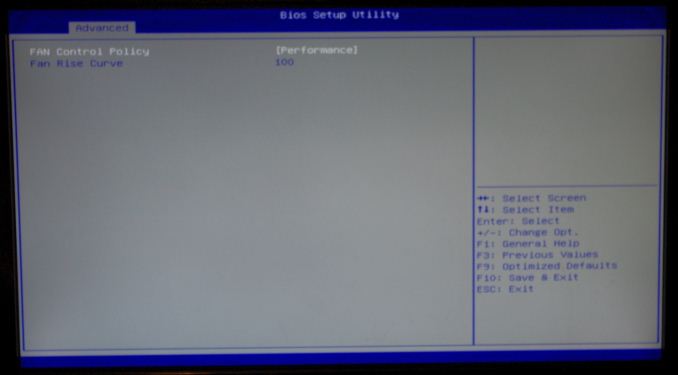
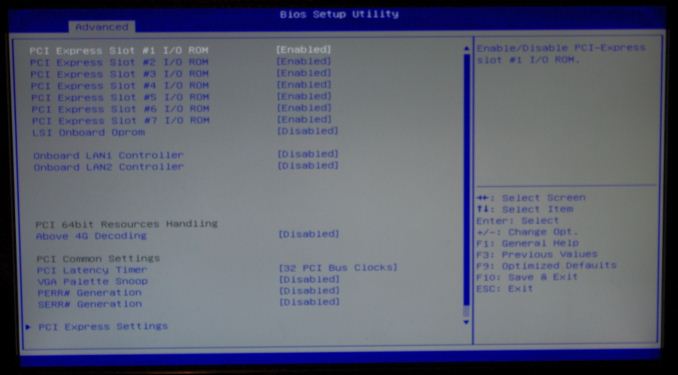
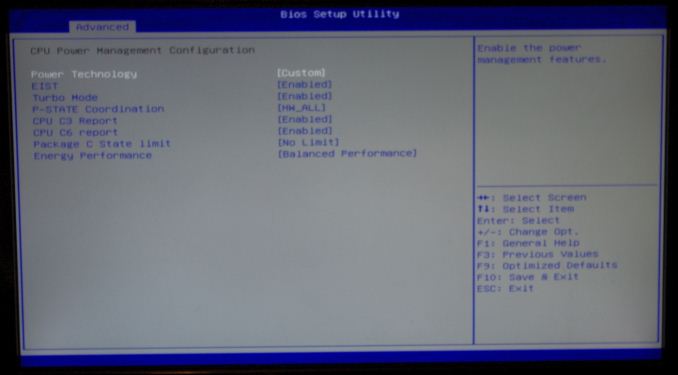
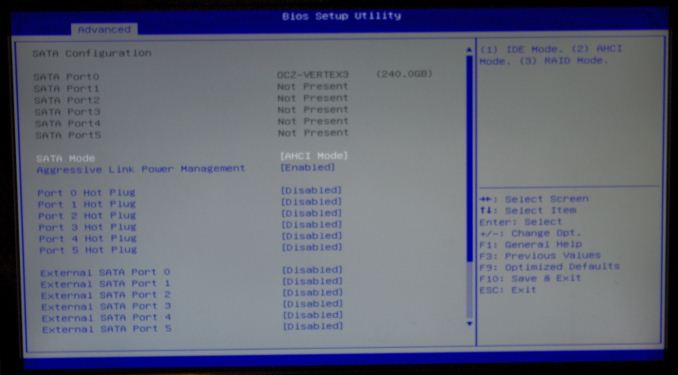
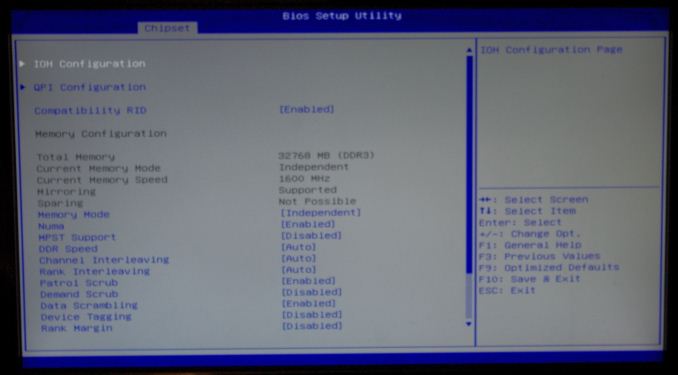
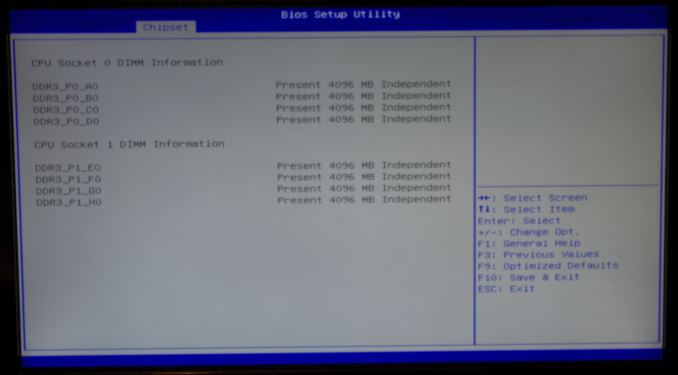
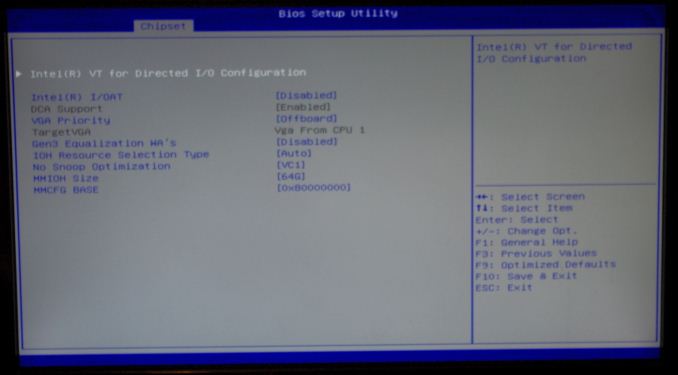






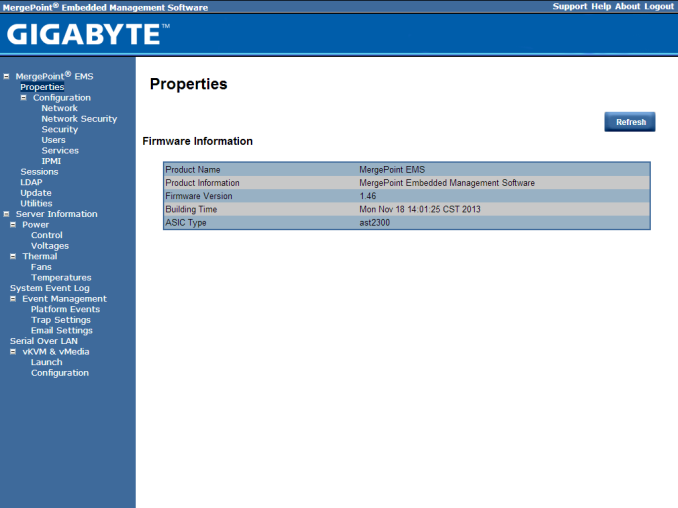
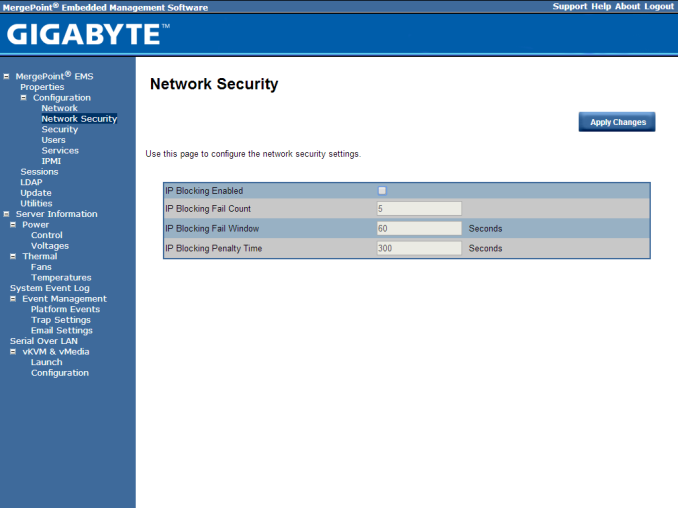
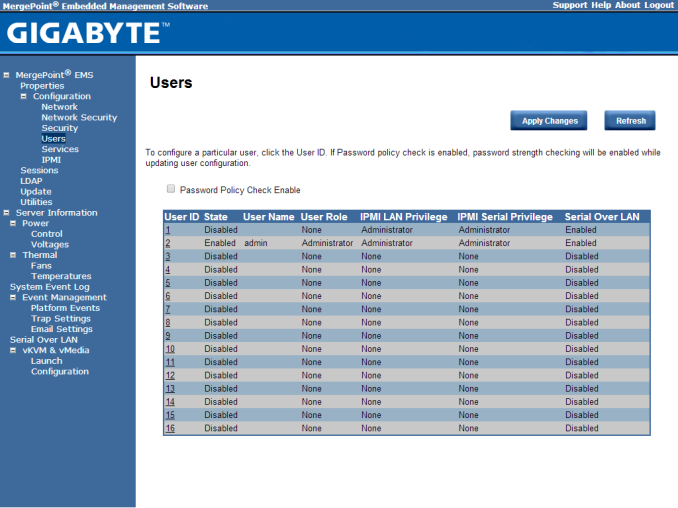
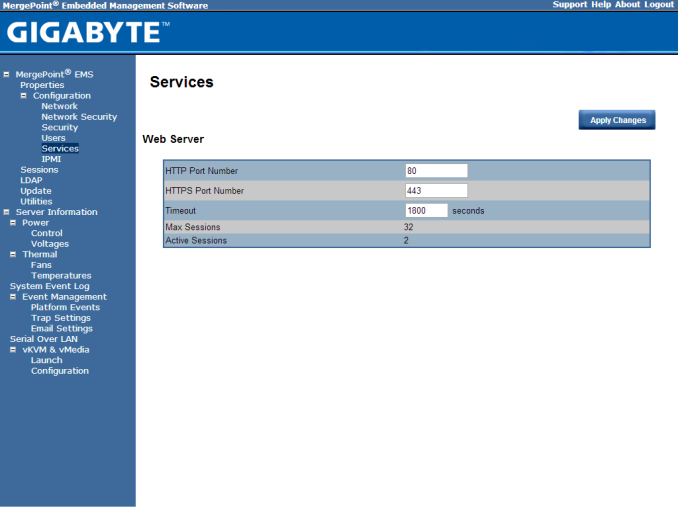
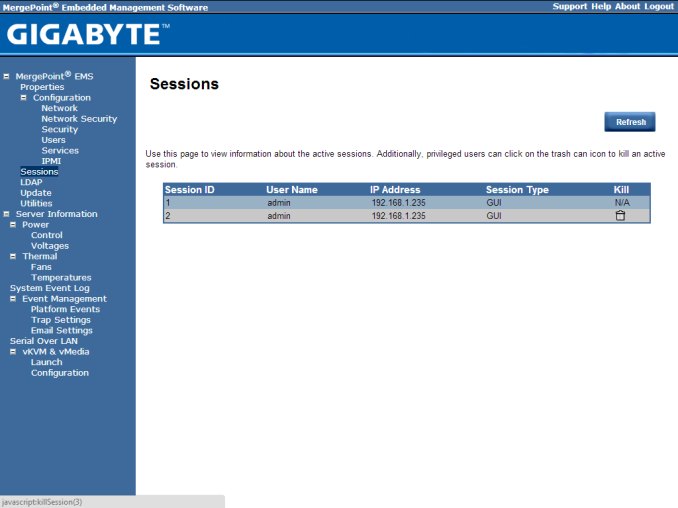
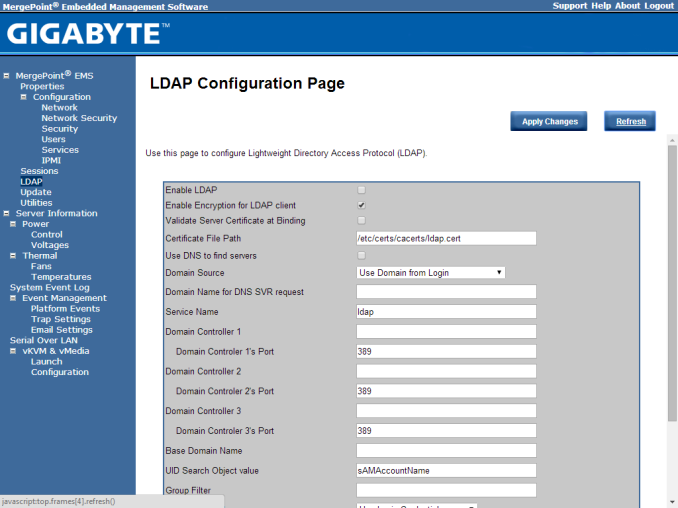
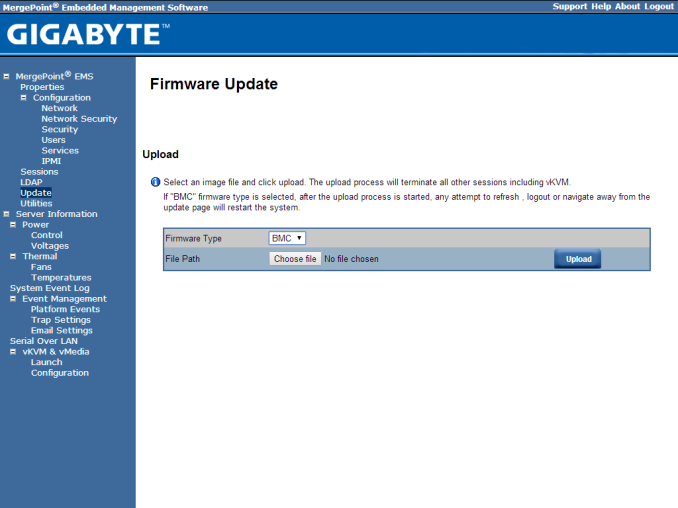
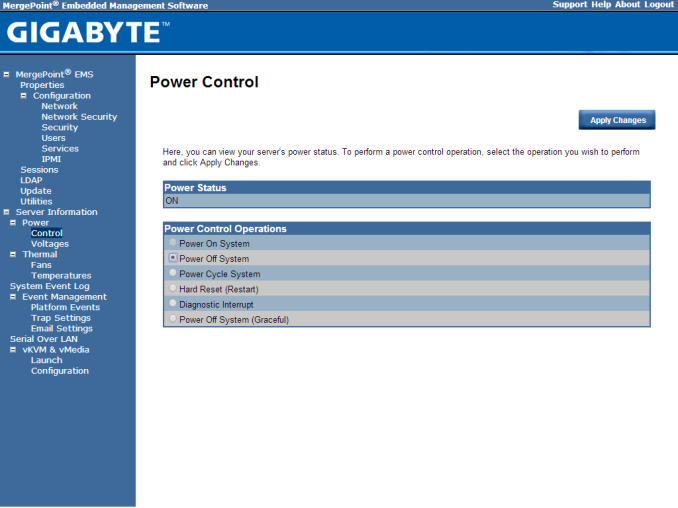
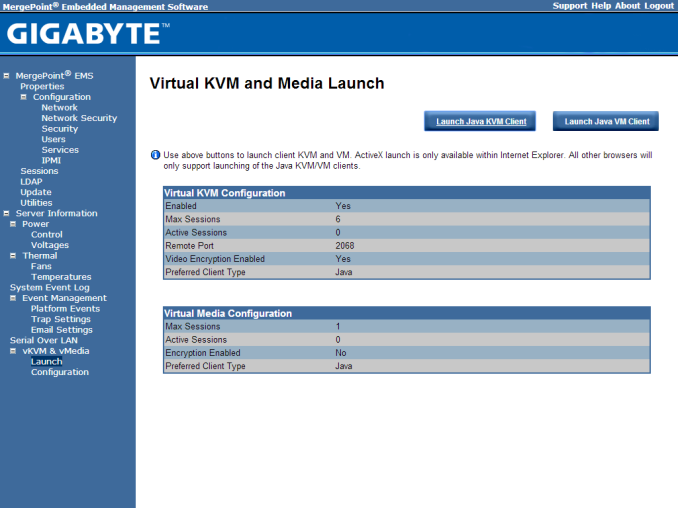
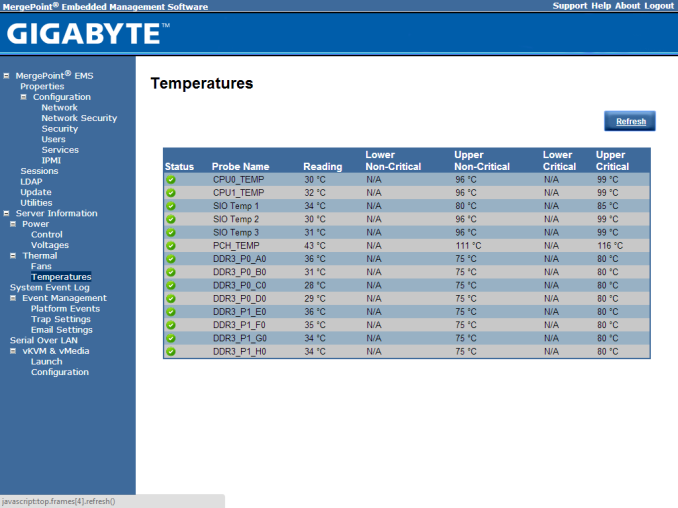
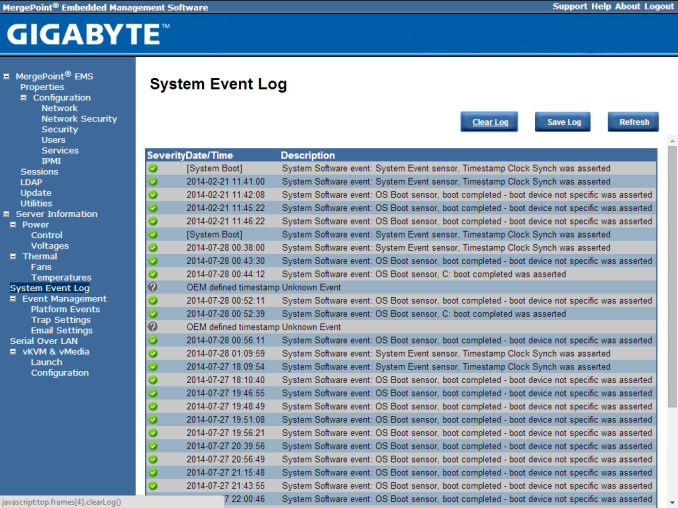
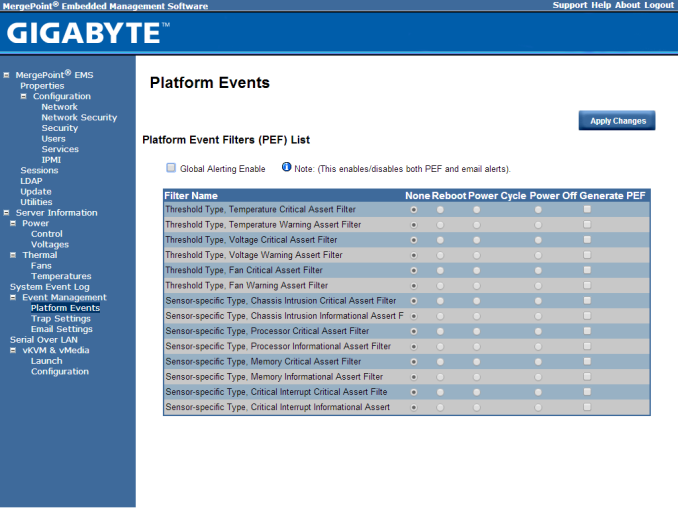














35 Comments
View All Comments
tuxRoller - Thursday, September 4, 2014 - link
So, you've got a workstation class board but are running Windows 8...Is it so difficult to throw centos on there for the benefit of those working at Pixar?
MrSpadge - Friday, September 5, 2014 - link
Those working at Pixar likely won't need an Ivy-EP review. Apart from that.. I'm sure Ian is glad not to have to deal with CentOS :ptuxRoller - Friday, September 5, 2014 - link
Centos is easy to setup, and the new release is quite nice.My point with Pixar was that there are many serious creators who use Linux workstations, and not just for simulations. Unless you work in the area it's possible you may not know the prevalence of Linux among workstations, especially relative to windows 8, in my experience.
That aside, seeing the comparative performance numbers of the two OS's is useful to get an idea of what the hardware itself can do.
mpbrede - Friday, September 5, 2014 - link
I really hope that this crappy grammar is just an indication of haste and not of lower editorial standards now that Anand has left the room."As a result, gaming often sees a hit in performance, as well as basic tasks." -> ...result, gaming, as well as basic tasks, sees a hit...
"Interestingly GIGABYTE does not supply any extra power connectors for these PCIe slots, indicating that not each port might not be able to provide 75W when all are populated (e.g. seven graphics cards)." -> read it slowly, how many "nots" should there be in a single sentence?
aryonoco - Friday, September 5, 2014 - link
A server/workstation motherboard requires its own benchmarks.For anyone who is in the target market of this product, this review is absolutely worthless. Gaming benchmarks? Really?!
colonelclaw - Friday, September 5, 2014 - link
Thanks for the review. In the future please consider including the following benchmarks:3DSMax + Vray, Maya + VRay/Arnold/Renderman, Adobe Media Encoder, Adobe After Effects, Adobe Premiere Pro. Some VRay RT and Octane multi-GPU benchmarks would be a nice addition, too.
The one thing I find slightly strange about this motherboard is the low number of memory slots. All our DP motherboards have twice as many per processor (and many are full). I wonder why Gigabyte decided on just eight?
eanazag - Friday, September 5, 2014 - link
I think the point of making the board where the CPUs line up was to allow better airflow to the add-on cards (GPUs). Lining up the CPUs didn't allow for the normal # of mem. slots.In actuality I would think most buyers of this board would just go with one CPU. It allows for the video compute cards to have more juice from the ATX 24 pin. I have bought 2P boards for one proc because of the peripheral items like slots, networking, RAID, and built-in network management. When you look at non-server boards and add the pricing of add-on management it starts to make you consider the server/workstation board.
The Von Matrices - Friday, September 5, 2014 - link
The reason for this is because Gigabyte chose to use square ILM sockets.For those who do not know, LGA2011 has two sockets - square ILM and narrow ILM. Most consumer motherboards use the square ILM sockets; you only see the narrow ILM sockets in servers. The narrow ILM socket is obviously narrower, which allows more memory slots on the same size motherboard. The disadvantage of the narrow ILM socket is that the memory slots are so close to the processor that large and quiet tower heatsinks can't be used since they cover the closest memory slots.
Basically, when designing a dual LGA2011 SSI CEB motherboard, you have to choose two of the three following features:
16 DIMM slots
7 PCIe slots
Square ILM sockets
If you use 16 DIMMs and 7 PCIe slots, you have to use narrow ILM sockets, which eliminates the use of tower heatsinks.
If you use 7 PCIe slots and square ILM sockets (like Gigabyte did) you now can use tower heatsinks. However, then there is only enough space on the motherboard for 8 or 12 DIMM slots.
If you use 16 DIMMs and square ILM sockets, there's only enough space on the motherboard for 6 PCIe slots.
joannecdinkins - Friday, September 5, 2014 - link
just as Larry answered I didnt even know that people able to get paid $6104 in a few weeks on the internet .go to this site>>>>> paygazette.ℭOM
KAlmquist - Friday, September 5, 2014 - link
One thing that's not addressed in this review is whether it makes sense to run Windows 7 on a multi-socket system. The benchmarks showing dual E5-2687W processors running significantly slower than a single E5-2687W suggest that Windows 7 is making bad scheduling decisions. Would Windows Server or Linux do better?Let me explain my point about scheduling decisions in a bit more detail. If you run a piece of software on a system with a single processor, the operating system has to make decisions about when to run each thread, and which core to run it on. Now switch to a system which is similar to the first system except that it has two processors. If the operating system simply ignores the second processor, and makes the same scheduling decisions as it made on the first system, then the performance of the two systems should be quite close. I'm not suggesting that this approach to scheduling on a dual processors system makes sense, but it is a possible approach. So if the approach to scheduling used by Windows 7 results in even worse performance, we know that Windows 7 could do better. In fairness to Microsoft, Windows 7 is not marketed as a server OS, so maybe it shouldn't be expected to perform well on server hardware.